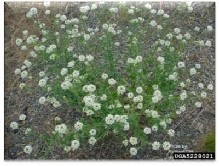Also Known as: false hoary madwort, hoary alyssum, hoary false alyssum, hoary berteroa, healbite
Hoary alyssum is a Class B Noxious Weed: Non-native species that are either absent from or limited in distribution in some portions of the state but very abundant in other areas. The goals are to contain the plants where they are already widespread and prevent their spread into new areas
Hoary Alyssum (Berteroa incana (L.) DC), a member of the mustard family, is an annual to short-lived perennial herb that is native to Eurasia. This tap-rooted plant emerges in early spring. The basal rosette of hoary alyssum has oval to lance-shaped leaves that are long-stalked and broader near the tip. Hoary alyssum reaches 2 ½–3 feet tall when mature, standing erect or nearly erect and branching at the top. Stem leaves have smooth margins and are gray-green, alternate, stalkless or nearly so, and taper to a point. A grayish down of star-shaped hairs covers the plant (including seed pods), giving it a silver-gray (or “hoary”) appearance. Flowers of the plant are arranged in clusters at stem ends. Individual flowers are small, white, and have 4 petals that are so deeply lobed that there may appear to be 8. The flowers bloom from spring through fall—a long period during which a single plant can produce over 2,500 seeds—the species’ only means of reproduction. Fruit of the plant consist of oblong seed pods that are flattened, chambered, and positioned close to the stem; each pod contains 4–12 reddish-brown lens-shaped seeds.
The seeds of hoary alyssum are spread by vehicles, equipment, wildlife, human activity, or via contaminated hay. Hoary alyssum is an aggressive invader of areas stressed by environmental influences (e.g., drought, winterkill) or by poor land management (e.g., overgrazing). It displaces native plant species and is particularly adapted to dry, disturbed sites with sandy or gravelly soils and sparse vegetation.
Although the toxicity of hoary alyssum to ruminants (cattle, sheep, goats) is not known, horses are susceptible and have been known to experience symptoms such as fever, diarrhea, edema and laminitis, reportedly upon ingesting a threshold of 30% contaminated forage. Horses can die if they ingest large quantities of the plant.
Control Methods
Cultural: Hoary alyssum can be suppressed by maintaining healthy plant communities (using strategies such as crop rotations and/or managed grazing, nutrient, and irrigation management) and by reseeding after significant disturbances. Prescribed burns may also be a feasible control option, although further studies are needed.
Physical/Mechanical: Small infestations of hoary alyssum can be hand-pulled or dug out—the entire root system should be removed to prevent resprouting and removal efforts should precede flowering to prevent seed production. Mowing or cutting can prevent the plant from going to seed but may have to be repeated over the long-term for effective control.
Chemical: Hoary alyssum can be controlled using herbicides such as glyphosate, metsulfuron methyl, metsulfuron methyl+aminopyralid and flumioxazin. Retreatment may likely be necessary to kill new plants growing from the seed bank.
More information can be found in the PNW Weed Management Handbook
Use pesticides with care. Apply them only to plants, animals, or sites listed on the label. When mixing and applying pesticides, follow all label precautions to protect yourself and others around you. It is a violation of the law to disregard label directions. Store pesticides in their original containers and keep them out of the reach of children, pets, and livestock.
Biological: No biological control agents are available.
Questions: contact Steve Van Vleet or phone (509) 397 – 6290
Photo credits included in PDF





